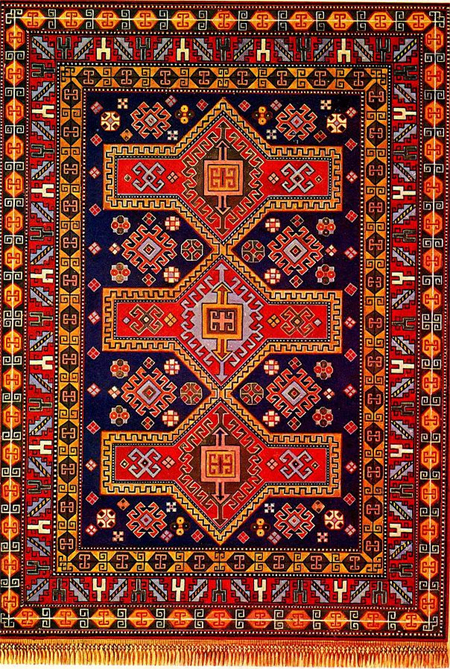Genje carpet school embraces Genje and the surrounding villages.
Genje, one of the ancient cities of Azerbaijan, is located in north-west of the country. Documents dating as far back as 11th century, suggest Genje as being a famous center of production of silk, and silk carpets.

Antique Gendje rugs have wool foundation and long pile, and as most rugs from the Caucasus are hand-knotted in the Turkish or Symmetrical knot.

Antique Gendje rugs are usually long and narrow displaying the distinctive feature pattern of many-colored diagonal stripes featuring small floral designs, sometimes alternating with rows of boteh motif.


Some Genje rugs are neither long nor narrow, villages such as Chiragl, Samukh, Chayli or Gedebey are known to have produced rugs that show a variety of pattern inspired by other works from the Caucasus.



The Genje boteh (Paisley) rugs are very popular among collectors, unlike many other rugs featuring the popular all-over design, Genje rugs present the boteh in the classic Genje diagonal stripe composition.

‘Buta/Boteh has been used in Iran, Central Asia and Caucasus since the Sassanid Dynasty (AD 224 to AD 651). Some design scholars believe the Boteh is the convergence of a stylized floral spray and a cypress tree: a Zoroastrian symbol of life and eternity. A floral motif called Buteh, which originated in the Sassanid Dynasty (200–650 AD) of Iran and later in the Safavid Dynasty (from 1501 to 1736), was a major textile pattern in Iran and Caucasus during the Qajar Dynasty.
In these periods, the pattern was used to decorate royal regalia, crowns, and court garments, as well as textiles used by the general population. According to Azerbaijani historians, the design comes from ancient times of Zoroastrianism and is an expression of the essence of that religion. It subsequently became a decorative element widely used in Azerbaijani culture and architecture.
The pattern is still popular in Iran and South and Central Asian countries. It is woven using gold or silver threads on silk or other high quality textiles for gifts, for weddings and special occasions.
The usage of the pattern goes beyond clothing – paintings, jewelry, frescoes, curtains, tablecloths, quilts, carpets, garden landscaping, and pottery also sport the buta design in Azerbaijan, Iran and Central Asia.
Buta/Boteh is also one of the most important ornamental motifs of Mughal Indian art, consisting of a floral spray with stylized leaves and flowers. It is used in architecture and painting and in textiles, enamels, and almost all other decorative arts. The motif began to gain importance in the reign of the Mughal emperor Jahangir (1605–27).
Boteh/buta motif may have different meanings in the different cultures: Zoroastrian flame, shrub, Scythian decorative motif, a bird, flower, cypress tree etc.’ (source http://www.azerbaijanrugs.com/arfp-genje-ancient_genje-boteh-rug-104x168cm.htm)
Watch an insightful documentary on the Genje Carpet School (Group) Approx. 40 min
to be continued …
